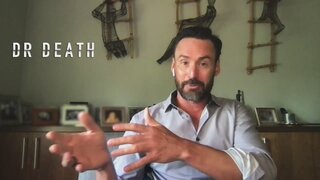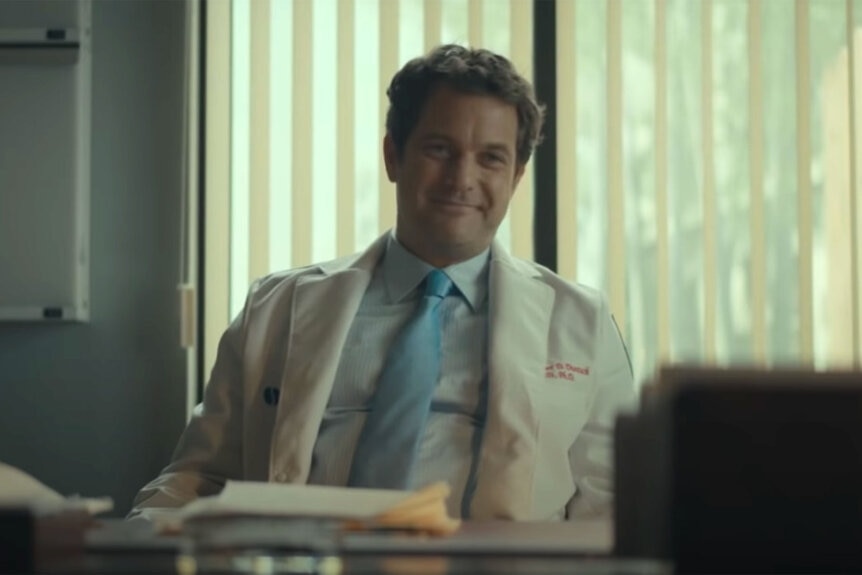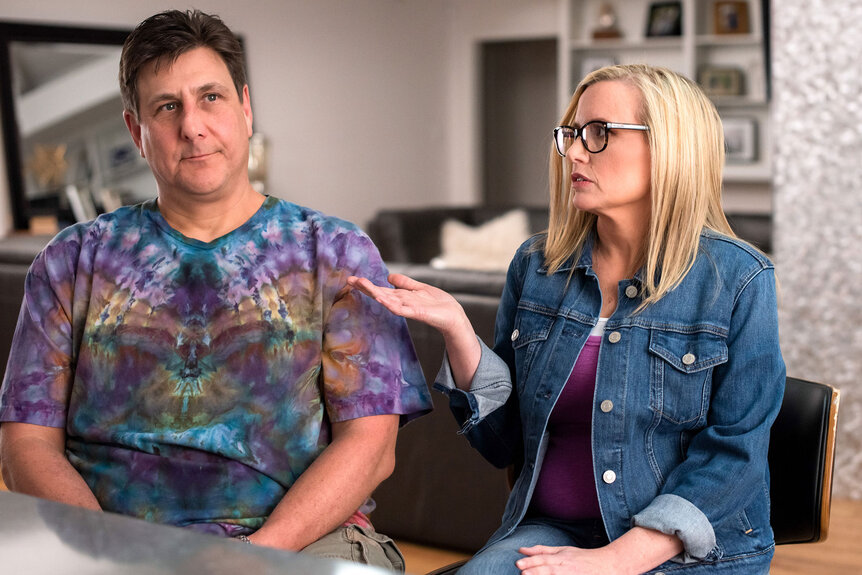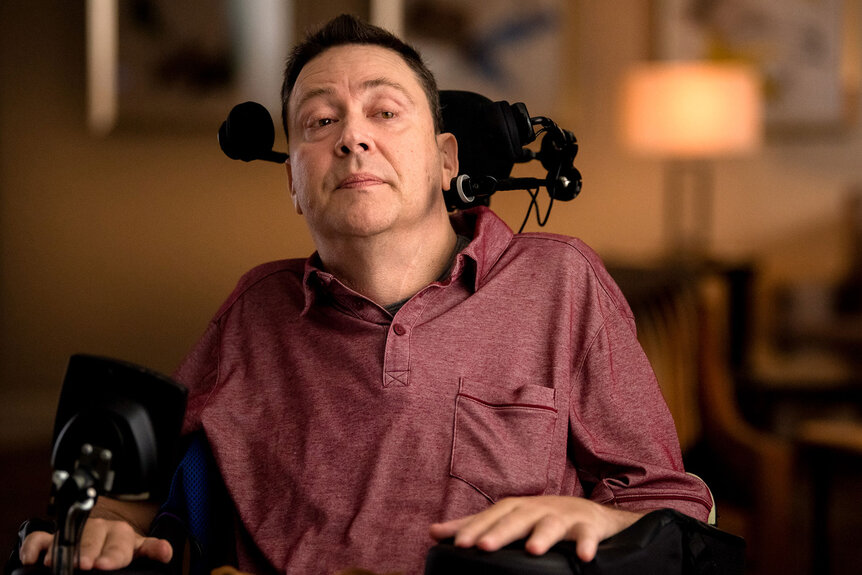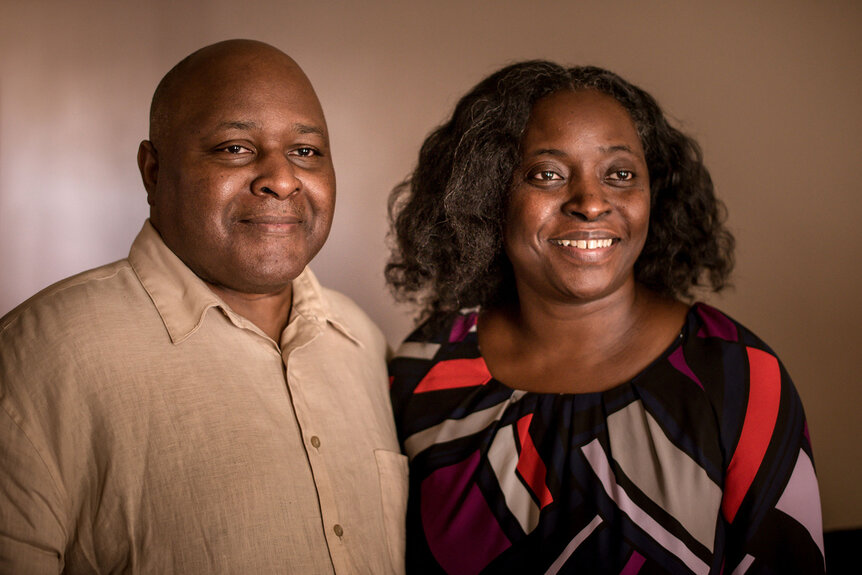Create a free profile to get unlimited access to exclusive videos, breaking news, sweepstakes, and more!
Who Were The Victims Of Dr. Christopher Duntsch, Who Earned The Ominous Nickname ‘Dr. Death’?
Dr. Christopher Duntsch appeared to have an impressive resume, but left a trail of pain and devastation for those who trusted him with their health.
There was just one thing standing in the way of Kellie Martin’s tropical vacation to the island of Antigua with her husband.
The school librarian had tweaked her back after falling off a ladder while taking down Christmas decorations and needed a simple surgery to repair a torn piece of disc material compressing the nerves in her back and causing her pain, according to a 2019 episode of Oxygen’s “License To Kill.”
Martin selected Dr. Christopher Duntsch, a neurosurgeon with a glowing reputation, to perform the surgery at Baylor Plano Hospital.
It was just one simple procedure before her trip, but Martin would never to make it Antigua or see her husband or two adult daughters again.
Martin died at the hospital after Duntsch cut a blood vessel and tore a hole in a vein, causing her to bleed to death.
“I remember that moment when they said, ’Kellie is no longer with us,’ my sister lets out this scream that I will never forget and I stand up and say ‘Why? Why did this happen?’” Martin’s daughter Lauren Hardman would later recall in “License to Kill.”
Martin’s death came just a few months after Duntsch had paralyzed his closest friend, Jerry Summers, in another botched surgery that left Summers a quadriplegic, but they were far from his only victims.
According to prosecutors, Duntsch injured 33 out of 38 patients in less than two years, moving from one hospital to another until his medical license was suspended and he was charged with aggravated assault for injuring elderly patient, Mary Efurd.
Duntsch’s trail of destruction is now the focus of the new Peacock limited series “Dr. Death,” which tells a dramatized version of the story and stars Joshua Jackson, Christian Slater and Alec Baldwin. (And if you want to dive even deeper into the story, you can also watch the new docuseries "Dr. Death: The Undoctored Story" on Peacock, which features interviews with numerous people intimately involved in the case.)
But just who were Duntsch’s real life surgical victims? Here’s what we know about some of people who went under the knife:
Lee Passmore: Lee Passmore, an investigator with the Collin County Medical Examiner’s office, was referred to Duntsch by his pain specialist and went into surgery on Dec. 30, 2011.
Vascular surgeon Mark Hoyle, who assisted with the operation, would later testify that he observed Duntsch cut out a ligament around the spinal cord that isn’t normally touched in the back surgery, misplace hardware in Passmore’s spine and strip the screw that kept the hardware in place, making it impossible to move the device, according to ProPublica. Hoyle was so disturbed by Duntsch’s actions that at one point he either grabbed the scalpel or blocked the incision, then later vowed never to return to the operating room with the surgeon again.
Passmore would later testify that the surgery left him in chronic pain and made it difficult for him to walk.
Barry Morguloff: In January of 2012, Barry Morguloff went to Duntsch for a spinal fusion, a procedure that joined two vertebrae together using a metal plate, after getting a referral from a pain clinic.
Duntsch vowed to help Morguloff—who had injured his back unloading trucks—walk without pain again.
“’I can fix you’ was like the magic word, boom that’s all I heard,” Morguloff recalled in the Peacock docuseries. “I thought that he was gonna be the man to help me walk again.”
Fellow doctor, Randall Kirby—portrayed in the series by Slater—assisted in the surgery and would later write to the Texas Medical Board that Duntsch had problems throughout the simple procedure, nicking the patient’s vertebral artery and having difficulty moving the plate into the proper place, according to The Texas Observer.
“His performance was pathetic. … He was functioning at a first- or second-year neurosurgical resident level but had no apparent insight into how bad his technique was,” Kirby wrote.
Morguloff ended up in more pain than he had been before the procedure, and had no feeling in his left leg.
“I woke up in recovery room and felt like I had been hit by a truck,” he said in the podcast “Dr. Death,” hosted by Laura Beil. “I had never experienced pain of this type before.”
His attorney Mike Lyons said he was in constant pain for the next several months and had bone fragments from the vertebrae lodged into the nerves of his back, according to The Texas Observer.
Morguloff was left with bone fragments from the vertebrae lodged into the nerves of his back and said in the docuseries that “pain rules my life.”
“I went to a psychiatric facility to keep from killing myself. It was hard,” Morguloff admitted. “I didn’t do it. I tasted the barrel of the 9mm and it was very hard to go on, but I had a wife and child.”
Jerry Summers: Jerry Summers had not only been Duntsch’s patient, he had also been his close friend, even moving to Dallas from Tennessee to help the neurosurgeon set up his new practice, according to the podcast.
Summers asked his pal to operate on him because of chronic neck pain he had from a car accident. But the surgery would have drastic consequences.
Doctors who reviewed the case would later determine that during the surgery Duntsch had damaged the vertebral artery, which caused it to bleed significantly.
To try to stop the bleeding, Duntsch packed the space with a so much anticoagulant gel foam, that it constricted Summers’ spine, and removed so much of his bone that Summers’ head was no longer secure on his body, according to the podcast.
Summers would wake up paralyzed from the waist down.
“As soon as I woke up, I couldn’t move my arms or my legs,” Summers said in “Dr. Death: The Undoctored Story.” “It feels like a big pile of bricks is on your body and your head is sticking out. I knew something was wrong.”
Summers was in intense pain and used the only thing he had left, his voice, to plead for help.
“All Jerry would say to me is, ‘I want to die. Kill me, kill me, I want to die,’” Jennifer Miller, his girlfriend at the time, said in the podcast.
Summers died earlier this year from an infection connected to his status as a quadriplegic, local station WATN reports.
Summers’ attorney Jeffrey Rosenblum said before Summers died, he had forgiven his friend for what happened during the surgery.
Kellie Martin: Just months after Summers was left paralyzed, Martin would lose her life after going under the knife.
After Summers’ botched surgery, Duntsch had been instructed to perform only minor procedures. Martin would be his first patient after he passed a psychological evaluation, but this time the botched surgery would cost Martin her life.
“My mother’s last moments on earth she was bleeding to death? I mean, we’re in a hospital. Can’t they stitch her up or find the wound and you know, stop the bleeding?” Hardman said in the Peacock docuseries.
Don Martin, Kellie’s husband, told “License to Kill” that he and her daughters were allowed to see his wife’s body one final time at the hospital. He cut locks of her hair as a memento.
“We all had to drive home in separate cars,” he said of his two daughters. “You’re driving home and you’re thinking, ‘Good God, what now?’”
Floella Brown: Several months later, in July of 2012, Duntsch left Baylor Plano and secured temporary surgical privileges at Dallas Medical Center. It was there he met 64-year-old Floella Brown, a banker about to retire, who was hoping to ease her worsening back pain, ProPublica reports.
The cervical fusion initially seemed to be going well, but operating room nurse Kyle Kissinger said Duntsch soon began complaining that there was too much bleeding.
“He was saying: ‘There’s so much blood I can’t see. I can’t see this,” Kissinger said.
In the recovery room, Brown said she felt okay and had visits from her husband Joe, son and granddaughter that night, according to the podcast. But by 5 a.m. the next morning, Brown was convulsing and lost consciousness.
Duntsch couldn’t be reached for hours and arrived at the hospital late, looking disheveled, in the same scrubs he had worn for three days—distinctive because of the large hole they had in the butt cheek, Kissinger recalled in the podcast.
“The moment he walked in that morning, I immediately got to him and said ‘Look, you need to call upstairs. There’s something wrong with your patient from yesterday.’ It was at first met with little concern, almost like he was blowing it off,” Kissinger said in the docuseries.
Rather than tend to Brown, who was in the ICU, Duntsch carried out yet another surgery. The Texas Medical Board would later conclude that Brown died of excessive blood loss and a stroke, according to The Texas Observer.
Mary Efurd: While Brown was dying, Duntsch was operating on Mary Efurd, a 71-year-old anxious to return to her treadmill after surgery to relieve her back pain.
But, according to Kissinger, Duntsch was distracted during the surgery and preoccupied with his thoughts about Brown, even getting into an argument with Kissinger and his supervisors about his idea to perform a craniotomy on Brown—a procedure the hospital did not have the proper equipment to do.
“It was getting to a surreal moment,” Kissinger said in the docuseries. “Dr. Duntsch is in the middle of Mary Efurd’s surgery and he wants to do a craniotomy on Ms. Brown. Basically, he wanted to cut a hole in the back of her skull to release some tension off of the brain.”
Duntsch struggled to put the necessary hardware in Efurd during the procedure incorrectly placing it in muscle rather than bone, and she would later wake up in agonizing pain and unable to move her legs.
Dr. Robert Henderson, portrayed in the Peacock series by Baldwin, was called in to try to repair the damage.
“Immediately upon opening the patient’s prior scar, I could see a screw penetrating that dural sac from the left side at the bottom. It was just wobbly there. It was like somebody just threw some tinker toys in there or an erector set in there,” Henderson said on “License to Kill.” “I had absolutely zero comprehension of how this surgeon could think that he had done the procedure correctly.”
Duntsch had also amputated Efurd’s nerve root and placed a screw into the S1 nerve root, Henderson said, according to the Texas Observer.
Dallas County prosecutors would later charge the surgeon for injuring an elderly patient in connection with Efurd’s case, sending him to prison for life.
Jeff Cheney: Cheney, a father to three and grandfather to six, went to Duntsch to try to relieve pain that moved from his shoulder down his arm in September of 2012.
“Dr. Duntsch assured me I’d be 100 percent pain-free immediately after the surgery,” Cheney said in the docuseries. “He definitely had confidence.”
But when Cheney woke up from the surgery, he “felt like I’d been run over by a steam roller.”
He was unable to move anything on the right side of his body.
“Dr. Duntsch looked down at me and he said, ‘I don’t know why you’re this way. Everything went perfect in there,’” Cheney said.
Cheney said he’d later learn that part of his spinal cord had been cut. He was left with pain so debilitating, he was unable to work as a mechanic any longer and spends most of his days at home.
“The fact that I can’t just reach down and pick up a grandchild, and hold them in my arms, I feel like I am missing a lot,” he said in the Peacock docuseries.
Marshall ‘Tex’ Muse: Marshall ‘Tex’ Muse’s passion for running left him with degenerative disc disease. Like many others, Muse reached out to Duntsch for help.
“He took my X-rays and he said, ‘You should have had surgery five years ago. We need to get you in and get you in now,’” Muse recalled in the docuseries.
Just days later, Muse was scheduled to go under the knife at the Legacy Surgery Center in Frisco, but the night before his surgery he learned online of Martin’s death just months earlier.
“I called Dr. Duntsch up and I said, ‘I saw this online.’ Immediately, he started yelling and cussing at me, saying ‘How dare you? I can’t believe that you’re accusing me of killing someone,’” Muse recounted. “He said the patient died from having an allergic reaction to the anesthesia.”
The explanation was enough to satisfy Muse, but he’d wake up from the surgery in intense pain.
“This pain was just like someone had a jack hammer with a knife on the end and they were just holding it into my spine,” Muse said.
Duntsch assured him it was normal and that he was overreacting and prescribed so much pain medication that the pharmacist refused to fill the order a second time because “the doctor is going to kill the patient,” Muse said.
Muse spiraled into addiction, losing his job and splitting from his wife in the process.
“This whole thing changed my life in so many ways,” he said.
Another doctor would later determine Duntsch had never installed the necessary hardware to the spine and instead had left it floating between the spine and muscle tissue.
Jacqueline Troy: Jacqueline Troy was left barely able to speak above a whisper after Duntsch mistakenly cut her vocal chords and one of her arteries at Legacy Surgery Center in Frisco in December of 2012, according to ProPublica.
“It was like a nightmare,” Troy later told jurors, according to local station WFAA. “I woke up in a nightmare.”
During the surgery, Troy’s esophagus had been pinned under a plate near her spine and Duntsch had poked holes in her trachea. She was left with just one vocal chord, impairing her ability to speak.
“She didn’t know what was going on, she didn’t know what had happened to her,” her husband Tom Troy testified during the punishment phase of Duntsch’s trial.
Troy had to be sedated for weeks and was initially forced to eat through a feeding tube because food was getting into her lungs.
Dr. Martin Lazar, who reviewed Duntsch’s cases for the prosecution, called the surgery and “unmitigated disaster.”
Pam Trusty: Pam Trusty once sang Duntsch’s praises in a video testimonial the disgraced doctor used to lure more clients, but her words now continue to haunt her.
“It’s a miracle,” she said in the infomercial later promoted on his website, according to the docuseries. “Dr. Duntsch is one great man.”
Trusty was never told she was participating in an infomercial and believed Duntsch had been selected as the top neurosurgeon in Dallas and was participating in a video about the award. Duntsch had approached her about making the video during a follow-up visit where she was still in pain. He told her that was normal.
Trusty would later find out there was no award and it had just been a paid advertisement. She now considers herself to be one of the lucky patients.
“I could walk and I was on this top side of the ground,” she said.
But she’s still tormented by the knowledge that her endorsement caused others, like Duntsch’s final patient Jeffrey Glidewell, to select Duntsch themselves.
“I felt like it was because of me and you know, the words that will forever haunt me is that he was one great man,” she said in the docuseries as her voice breaks.
Philip Mayfield: Philip Mayfield loved his job as a professional truck driver for nearly 20 years—but the long drives had also given him chronic back pain. Mayfield hoped to alleviate the pain in a simple 45-minute surgery on April 9, 2013, but like many of Duntsch’s other victims, the surgery would end in agonizing pain.
Duntsch told Philip’s wife Angela that everything went well, but in the recovery room Philip could not hold himself up.
“He had no control, no support of his own. He was just flopping around,” Angela told Esquire, adding that he could barely speak because of severe pain.
Mayfield was taken to a different hospital and received a new doctor, but his spinal cord had already been deformed and the damage was irreversible.
“They told me I’d never be able to walk again,” Philip told the news outlet. “But I told them, ‘Yes I will, yes I will walk again, I have a life that I have to live. I have three boys I need to raise.”
Mayfield was right—he eventually regained the ability to walk after intense rehab—but still walks with a cane, lives with chronic pain, has random fainting spells, and developed syringomyelia, a painful condition causing cysts on the spinal cord.
“My pain level would get so high, it stimulates the autonomic nervous system and I’m passing out,” Mayfield said in the docuseries. “You call the paramedics around here, you don’t even have to give them the address, they already know they are talking about me.”
He’d unfortunately die Feb. 12, 2021, his family wrote on a GoFundMe page.
Jeff Glidewell: The morning of his surgery, Jeff Glidewell, received what he thought was an ominous sign. On his drive to University General hospital, he saw three black cats cross his path.
Once at the hospital, he was forced to wait for hours hooked up to an IV, waiting for Duntsch, who arrived three hours late in a cab, ProPublica reports.
“He had on jeans that were frayed at the bottom,” Glidewell told the news outlet. “He didn’t look like he was ready for surgery.
Glidewell had been hoping to relieve back pain he had been suffering with since a motorcycle accident in 2004 and reluctantly went ahead with the procedure after reassurances from his wife, Robin.
“Jeff is wanting to leave but I was like ‘No.’ I really wanted Jeff to have the surgery so that hopefully he could get back to normal,” she told “License to Kill.”
But Jeff would only find himself in more pain after the surgery.
“I wake up from surgery and I knew something was wrong. I couldn’t feel my feet. I could not move my left arm, I couldn’t talk. I was in more pain than I ever thought imaginable and my wife walked over and she was crying,” he told “License to Kill.”
Duntsch told Robin they had to abort the surgery because he had discovered a tumor, which he thought could be cancer.
Kirby was called in to try to fix the procedure, and after transferring Jeff to another hospital, determined that the incision was in the wrong place, Duntsch had put a “hole the size of a silver dollar” in his esophagus, taken out a nerve, cut an artery and then left a sponge inside the body.
“He was septic. He had a bad blood-borne infection. Puss was pouring out his neck along with saliva,” Kirby said in the docuseries of Glidewell’s condition. “Dr. Duntsch left the sponge in because if he pulled the sponge out, Mr. Glidewell would have exsanguinated, he’d bleed to death, but you know, that’s not any long-term solution. That sponge has got to be removed. You’ve got to take care of whatever you injured.”
The material Duntsch believed to be a tumor was really just muscle.
“I have never seen a case like Mr. Glidewell’s,” Kirby said in the docuseries. “This was attempted murder and it wasn’t the first time. In my opinion, we had a serial killer in our medical community.”
Jeff would spend months in the hospital recuperating from the surgery that nearly killed him.
It would be Duntsch’s final procedure before his medical license was suspended. His license was later permanently revoked in December of 2013—finally ending his reign of pain and death.
"Dr. Death" and the companion docuseries "Dr. Death: The Undoctored Story" are both available to stream on Peacock now.


